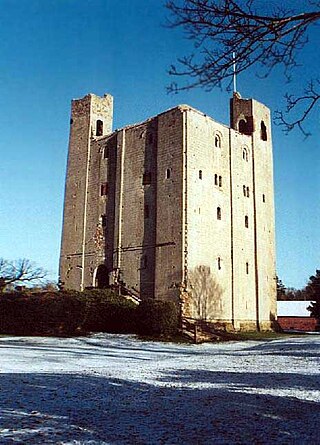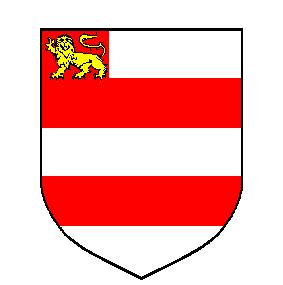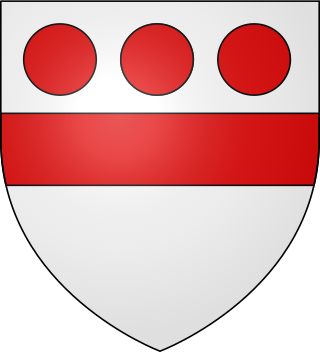
Penrith is a market town and civil parish in the Westmorland and Furness district of Cumbria, England. It is less than 3 miles (5 km) outside the Lake District National Park and about 17 miles (27 km) south of Carlisle. It is between the Rivers Petteril and Eamont and just north of the River Lowther. The town had a population of 15,181 at the 2011 census. It is part of historic Cumberland.
Beaupre is a surname found mostly in Canada, the United States and parts of England.

The Barony of Kendal is a subdivision of the English historic county of Westmorland. It is one of two ancient baronies that make up the county, the other being the Barony of Westmorland. In 1974, the entire county became part of the modern county of Cumbria and ceased to have an administrative function. At the same time, Kendal borough along with some other rural and urban districts in Westmorland was merged with the neighbouring parts of Lancashire, Furness and Cartmel, and also the Sedbergh Rural District of the West Riding of Yorkshire into the new South Lakeland district of the new county.

Inglewood Forest is a large tract of mainly arable and dairy farm land with a few small woodland areas between Carlisle and Penrith in the English non-metropolitan county of Cumbria or ancient county of Cumberland.

Waberthwaite is a small, former rural civil parish on the south bank of the estuary of the River Esk, in Copeland, Cumbria, England. Since 1934 it has been part of the combined parish of Waberthwaite and Corney, which covers 10 square miles and has a population of 246. It is located opposite Muncaster Castle and the village of Ravenglass which lie on the north bank of the Esk. It is well known for its Cumberland sausages, and lists among its other assets a granite quarry that is a Site of Special Scientific Interest (SSSI); the Esk estuary, which forms part of the Drigg Coast Special Area of Conservation (SAC) - a designation for areas of European importance; the 800-year-old St. John's Church, and the remains of two Anglian/Norse crosses of an earlier period. Archeological finds within 3 kilometres of Waberthwaite indicate that the area has been continuously inhabited since Mesolithic times.

Aubrey de Vere, 1st Earl of Oxford was an English noble involved in the succession conflict between King Stephen and Empress Matilda in the mid-twelfth century.

The "Luck of Edenhall" is an enamelled glass beaker that was made in Syria or Egypt in the middle of the 14th century, elegantly decorated with arabesques in blue, green, red and white enamel with gilding. It is now in the Victoria and Albert Museum in London and is 15.8 cm high and 11.1 cm wide at the brim. It had reached Europe by the 15th century, when it was provided with a decorated stiff case in boiled leather with a lid, which includes the Christian IHS; this no doubt helped it to survive over the centuries.
Sir Gilbert Denys of Siston, Gloucestershire, was a soldier, and later an administrator. He was knighted by January 1385, and was twice knight of the shire for Gloucestershire constituency, in 1390 and 1395 and served as Sheriff of Gloucestershire 1393-4. He founded the family which provided more Sheriffs of Gloucestershire than any other.
Loders Priory was a priory in Loders, Dorset, England.
William de Lancaster I, or William Fitz Gilbert, was a nobleman of the 12th century in Northwest England during the Anarchy, and the period during which his region was ruled by King David I of Scotland. His position survived the return of English rule under King Henry II, and his most important lordship, which had previously come together under Ivo de Taillebois, would evolve into what was eventually known as the barony of Kendal. According to a document some generations later, he was also referred to as William de Tailboys when younger, and then became "William de Lancaster, baron of Kendal". He died in about 1170.

Robert de Vieuxpont, also called Vipont, Veteripont, or de Vetere Ponte, Baron of Westmorland, was an Anglo-Norman noble landowner and administrator.
Sir Philip Musgrave, 6th Baronet was a British politician.

From AD 1066, the feudal barony of Barnstaple was a large feudal barony with its caput at the town of Barnstaple in north Devon, England. It was one of eight feudal baronies in Devonshire which existed in the Middle Ages. In 1236 it comprised 56 knight's fees or individual member manors. The feudal service owed for half the barony in 1274 was the provision to the royal army of two knights or four sergeants for forty days per annum, later commuted to scutage.

Gilbert fitz Roger fitz Reinfried, or Gilbert the son of Roger fitzReinfrid, was an Anglo-Norman feudal baron whose administrative career in England began in the time of Henry II (1154-1189), for whom his father Roger fitzReinfrid had been steward, and continued during the reigns of Richard I, King John, and Henry III.

William Devereux, Baron Devereux of Lyonshall was an English noble who was an important Marcher Lord as he held Lyonshall Castle controlling a strategically vital approach to the border of Wales in the time of Edward I and Edward II. He was the first of this family officially called to Parliament, and was ancestor to John Devereux, 1st Baron Devereux of Whitchurch Maund, the Devereux Earls of Essex, and the Devereux Viscounts of Hereford. His coat of arms was the same as his father's and described as "argent, fess and three roundels in chief gules" which passed to the descendants of his first wife, the Devereux of Bodenham; or "gules od un fesse d'argent ove turteaus d'argent en le chief" which passed to the descendants of his second wife, the Devereux of Frome.
Stephen Devereux of Bodenham and Burghope was a member of a prominent knightly family in Herefordshire during the reigns of Edward I, Edward II and Edward III. An important retainer of the de Bohun Earls of Hereford, he gave rise to the Devereux Earls of Essex and Viscounts of Hereford.

Sir James Leyburn, also Laybourne, Labourn, etc., was a senior representative of one of the powerful families within the Barony of Kendal. He was at different times a Justice of the Peace for Westmorland, Escheator for Cumberland and Westmorland, and Commissioner for the survey of the monasteries of Lancashire. He was caught up in the troubles at Kendal during the Pilgrimage of Grace (1536-1537). As an assistant to Sir Thomas Wharton, Deputy Warden of the West March, he took an important part in the Battle of Solway Moss (1542). He was one of the two MPs for Westmorland in 1542 and 1545.

Sandleford Priory was a small Augustinian Priory, the remains of which now stand at Sandleford in the civil parish of Greenham in the English county of Berkshire.
John de Lancaster of Grisedale and Stanstead was an English knight, and a parliamentary baron in the Peerage of England. He was the first and last in his line to be called to parliament, as he had no heir. He was therefore the only "Lord Lancaster" or "Baron Lancaster" apart from the separate titles which belonged to a branch of the royal family descended from Edmund Crouchback. His father's family had many lordships in northwestern England, including Grisedale ; while his mother's family made him an heir to important lordships in other parts of England, including Stansted Mountfitchet in Essex.

Thomas Musgrave, Captain of Bewcastle was an English landowner and soldier involved in Scottish border politics. He was keeper of Bewcastle Castle for Elizabeth I.











